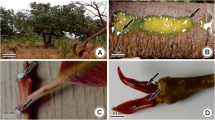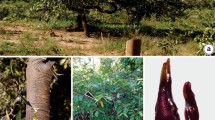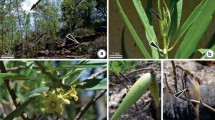Abstract
An in-depth understanding of the development and distribution of laticifer (latex secretory structure) will be important for the production of both rubber and medicines and will support studies on plant adaptations to their environments. We characterize here and describe the ontogenesis of the laticifer sytem in Calotropis procera (Apocynaceae), an invasive subshrub species in arid landscapes. Anatomical and histochemical evaluations of the primary and secondary structures of the stem were carried out on a monthly basis during a full year, with ultrastructural evaluations of laticifer on the stem apex during the rainy season. In the primary structure, laticifer differentiate early from procambium and ground meristem cells of the cortex and medulla and become concentrated adjacent to the external and internal phloem of the bicollateral bundles. In the secondary structure, laticifer differentiates from fusiform derivative cells of the phloem close to the sieve-tube elements. The laticifer is of the articulated, anastomosing, branched type, and it originates from precursor cells that loose the transversal and longitudinal walls by dissolution. Latex is a mixture of terpenes, alkaloids, flavonoids, mucilage, and proteins. The apical meristem and vascular cambium where the laticifer system begins its development are active throughout the year, including during the dry season. The vascular cambium produces phloem with laticifer precursor cells during the rainy season, with high temperatures and long days. The ability of C. procera to grow under water deficit conditions and produce laticifer throughout the year contribute to its wide distribution in arid environments.












Similar content being viewed by others
References
Agrawal AA, Konno K (2009) Latex: a model for understanding mechanisms, ecology, and evolution of plant defense against herbivory. Annu Rev Ecol 40:311–331. https://doi.org/10.1146/annurev.ecolsys.110308.120307
Almeida IVBD, Rêgo MM, Batista FRDC, Rêgo ER, Bruno RDLA (2019) Phenology of Calotropis procera (Ait.) WT Aiton accessions based on morphophysiological characteristics. RC 32:543–551. https://doi.org/10.1590/1983-21252019v32n227rc
Al-Snafi AE (2015) The constituents and pharmacological properties of Calotropis procera- an overview. Int J Pharm Rev Res 5:259–275
Alvares CA, Stape JL, Sentelha PC, Moraes Gonçalves JL, Sparovek G (2014) Köppen’s climate classification map for Brazil. Meteorol Z 22:711–728. https://doi.org/10.1127/0941-2948/2013/0507
Appezzato-Da-Glória B, Estelita MEM (2000) Development, structure and distribution of colleters in Mandevilla illustris and M. velutina (Apocynaceae). Braz J Bot 23:113–120. https://doi.org/10.1590/S0100-84042000000200001
Canaveze Y, Machado SR (2016) The occurrence of intrusive growth associated with articuled laticifers in Tabernaemontana catharinensis A.DC.A new record for Apocynaceae. Int J Plant Sci 177:1–23. https://doi.org/10.1086/685446
Cavalcante GS, Morais SM, André WPP, Araújo-Filho JV, Muniz CR, Rocha LO et al (2020) Chemical constituents of Calotropis procera latex and ultrastructural effects on Haemonchus contortus. Braz J Vet Parasitol 29:e001320. https://doi.org/10.1590/S1984-29612020045
Costa RG, Medeiros AN, Alves AR, Medeiros GR (2009) Perspectivas de utilização da flor-de-seda (Calotropis procera) na produção animal. Rev Caat 22:276–285. http://periodicos.ufersa.edu.br/index.php/sistema. Accessed 02 Feb 2022
David R, Carde JP (1964) Coloration différentielle dês inclusions lipidique et terpéniques des pseudophylles du pine maritime au moyen du réactif Nadi. CR Acad Sci Paris, 375 Série D. 258:1338–1340
Feucht W, Schmid PPS, Christ E (1986) Distribution of flavonols in meristematic and mature tissues of Prunus avium shoots. J Plant Physiol 125:1–8. https://doi.org/10.1016/S0176-1617(86)80237-1
Freitas CDT, Sousa Nogueira FC, Vasconcelos IM, Oliveira JTA, Domont GB, Ramos MV (2011) Osmotin purified from the latex of Calotropis procera: Biochemical characterization, biological activity and role in plant defense. Plant Physiol Biochem 49:738–743. https://doi.org/10.1016/j.plaphy.2011.01.027
Freitas CDT, Silva RO, Ramos MV, Porfírio CTMN, Farias DF, Sousa JS, Oliveira JPB, Souza PFN, Dias LP, Grangeiro TB (2020) Identification, characterization, and antifungal activity of cysteine peptidases from Calotropis procera latex. Phytochemistry 169:112163. https://doi.org/10.1016/j.phytochem.2019.112163
Frosi G, Oliveira MT, Cortez-Almeida J, Santos MG (2012) Ecophysiological performance of Calotropis procera: an exotic and evergreen species in Caatinga, Brazilian semi-arid. Acta Physiol Plant 35:335–344. https://doi.org/10.1007/s11738-012-1076-x
Gama TSS, Rubiano VS, Demarco D (2017) Laticifer development and its growth mode in Allamanda blanchetii ADC. (Apocynaceae). J Torrey Bot Soc 144:303–312. https://doi.org/10.3159/TORREY-D-16-00050
Gondaliya A, Rajput KS (2016) Stem anatomy and development of intraxylary phloem in Vallaris solanacea (Roth) Kuntze (Apocynaceae). J Indian Bot Soc 95:202–215
Gonçalves MP, Mercadante-Simões MO, Ribeiro LM (2018) Ontogeny of anastomosing laticifers in the stem apex of Hancornia speciosa (Apocynaceae): a topographic approach. Protoplasma 255:1713–1724. https://doi.org/10.1007/s00709-018-1262-9
Habib MAH, Ismail MZ (2021) Hevea brasiliensis latex proteomics: a review of analytical methods and the way forward. J Plant Res 134:43–53. https://doi.org/10.1007/s10265-020-01231-x
Hassan LM, Galal TM, Farahat EA, El-Midany MM (2015) The biology of Calotropis procera (Aiton) W.T. Trees 29:311–320. https://doi.org/10.1007/s00468-015-1158-7
Jensen WA (1962) Botanical histochemistry, principles and practice. W.H. Freeman and Co., London
Johansen DA (1940) Plant Microtechnique. McGraw-Hill Book, New York
Karnovisky MJ (1965) A formaldehyde-glutaraldehyde fixative of high osmolality for use in electron microscopy. J Cell Bio 27:137–138
Kaur A, Batish DR, Kaur S, Chauhan BS (2021) An overview of the characteristics and potential of Calotropis procera from botanical, ecological, and economic perspectives. Front Plant Sci 12:690806. https://doi.org/10.3389/fpls.2021.690806
Koppen W (1936) Das geographische system der klimate. In: Köppen WR, Geiger (eds) Handbuch der klimatologie. Gebrüder Bornträger, Berlin, 1: pp 1–44, part C
Labanca F, Ovesnà J, Milella L (2018) Papaver somniferum L. taxonomy, uses and new insight in poppy alkaloid pathways. Phytochem Rev 17:853–871. https://doi.org/10.1007/s11101-018-9563-3
Leme FM, Borella PH, Marinho CR, Teixeira SP (2020) Expanding the laticifer knowledge in Cannabaceae: distribution, morphology, origin, and latex composition. Protoplasma 257:1183–1199. https://doi.org/10.1007/s00709-020-01500-5
Lopes KLB, Thadeo M, Azevedo AA, Soares AA, Meira RMSA (2009) Articulated laticifers in the vegetative organs of Mandevilla atroviolacea (Apocynaceae, Apocynoideae). Can J Bot 87:202–209. https://doi.org/10.1139/B08-126
Marcati CR, Machado SR, Podadera DS, de Lara NOT, Bosio F, Wiedenhoeft AC (2016) Cambial activity in dry and rainy season on branches from wood species growing in Brazilian Cerrado. Flora 223:1–10. https://doi.org/10.1016/j.flora.2016.04.008
Medina MC, Sousa-Baena MS, Prado E et al (2021) Laticifers in Sapindaceae: structure, evolution and phylogenetic importance. Front Plant Sci 11:612985. https://doi.org/10.3389/fpls.2020.612985
Mercadante-Simões MO, Paiva EP (2013) Leaf colleters in Tontelea micrantha (Celastraceae, Salacioideae): ecological, morphological and structural aspects. CR Biol 336:400–406
Naidoo C, Naidoo Y, Dewir YH (2020) The secretory apparatus of Tabernaemontana ventricosa Hochst. ex A. DC. (Apocynaceae): Laticifer identification, characterization and distribution. Plants 9:686. https://doi.org/10.3390/plants9060686
Nicole M, Thouvenel JC, Giannotti J, Chrestin H, Geiger JP, Nandris D, Rio B (1991) The histology of Hevea brasiliensis phloem necrosis. For Path 21:27–35. https://doi.org/10.1111/j.1439-0329.1991.tb00299.x
Novaes LR, Calixto ES, Oliveira ML, Lima LA, Almeida O, Torezan-Silingardi HM (2020) Environmental variables drive phenological events of anemocoric plants and enhance diaspore dispersal potential: A new wind-based approach. Sci Total Environ 730:139039. https://doi.org/10.1016/j.scitotenv.2020.139039
O’Brien TP, Feder N, McCully ME (1964) Polychromatic staining of plant cell walls by toluidine blue O. Protoplasma 59:368–373
Oliveira CA, Mansano VF, Teixeira SP, Brandes AFN, Baratto LC, Leitão SG, Santana MN, Rodrigues IA, Paulino JV (2021a) Bloodwood: the composition and secreting-site of the characteristic red exudate that gives the name to the Swartzia species (Fabaceae). J Plant Res 134:127–139. https://doi.org/10.1007/s10265-020-01246-4
Oliveira CS, Messeder JVS, Teixido AL, Arantes MRR, Silveira FAO (2021b) Vegetative and reproductive phenology in a tropical grassland-savanna-forest gradiente. J Veg Sci 32. https://doi.org/10.1111/jvs.12997
Oliveira SHF, Negreiros D, Fernandes GW, Barbosa NPU, Rocha R, Almeida-Cortez JS (2009) Seedling growth of the invader Calotropis procera in ironstone rupestrian field and seasonally dry forest soils. Neotrop Biol Conserv 4:69–76. https://doi.org/10.4013/5117
Pereira CC, Boaventura MG, Cornelissen T, Nunes YRF, Castro GC (2022) What triggers phenological events in plants under seasonal environments? A study with phylogenetically related plant species in sympatry. Braz J Biol 84:e257969. https://doi.org/10.1590/1519-6984.257969
Pirolla-Souza A, Arruda ORC, Pace MR, Farinaccio MA (2019) Leaf anatomical characters of Rhabdadenia (Rhabdadenieae, Apocynaceae), their taxonomic implications, and notes on the presence of articulated laticifers in the genus. Plant Syst Evol 305:797–810. https://doi.org/10.1007/s00606-019-01608-z
Prado E, Demarco D (2018) Laticifers and secretory ducts: similarities and differences. In: Hufnagel L (ed) Ecosystem Services and Global Ecology. InTech. https://doi.org/10.5772/intechopen.75705
Ramos MV, Demarco DCS, Freitas IC, Teixeira CD (2019) Laticifers, látex and their role in plant defense. Trends Plant Sci. https://doi.org/10.1016/j.tplants.2019.03.006
Roland AM (1978) General preparations and staining of thin sections. In: Hall JL (ed) Electron microscopy and cytochemistry of plant cells. Elsevier, New York, pp 1–62
Sobrinho MS, Tabatinga GM, Machado IC, Lopes AV (2013) Reproductive phenological pattern of Calotropis procera (Apocynaceae), an invasive species in Brazil: annual in native areas; continuous in invaded areas of caatinga. Acta Bot Bras 27:456–459. https://doi.org/10.1590/S0102-33062013000200018
Souza AIRC, Castro KR, Gonçalves MP, Ribeiro LM, Mercadante-Simões MO (2021) The development of anastomosing laticifers in the stem apical meristema and vascular cambium of Hancornia speciosa (Apocynaceae) is related to climatic seasonality. Trees. https://doi.org/10.1007/s00468-021-02118-7
Tan D, Hu X, Fu L, Kumpeangkeaw A, Ding Z, Sun X, Zhang J (2017) Comparative morphology and transcriptome analysis reveals distinct functions of the primary and secondary laticifer cells in the rubber tree. Sci Rep 7:3126. https://doi.org/10.1038/s41598-017-03083-3
Tavares LS, Ralph MT, Batista JEC et al (2021) Perspectives for the use of latex peptidases from Calotropis procera for control of inflammation derived from Salmonella infections. Int J Biol Macromol 171:37–43. https://doi.org/10.1016/j.ijbiomac.2020.12.172
Teixeira SP, Marinho CR, Leme FM (2020) Structural diversity and distribution of laticifers. Adv Bot Res 93:27–54. https://doi.org/10.1016/bs.abr.2019.09.003
Thomas V, Dave Y (1989) Histochemistry and senescence of colleters of Allamanda cathartica (Apocynaceae). Ann Bot 64:201–203. https://doi.org/10.1093/oxfordjournals.aob.a087826
Viana CA, Ramos MV, Marinho-Filho JDB, Lotufo LVC, Figueiredo IST, Oliveira JS, Mastroeni P, Lima-Filho JV, Alencar NMN (2017) Cytotoxicity against tumor cell lines and anti-inflammatory properties of chitinases from Calotropis procera latex. Naunyn Schmiedebergs Arch Pharmacol 390:1005–1013. https://doi.org/10.1007/s00210-017-1397-9
Vidal BC (1970) Dichroism in collagen bundles stained with Xylidine-Ponceau 2R. Ann Histochim 15:289–296
Acknowledgements
The authors acknowledge the Centro de Microscopia da Universidade Federal de Minas Gerais (CM/UFMG) for the ultrastructural analyses.
Funding
The authors thank the Fundação de Amparo à Pesquisa do Estado de Minas Gerais (FAPEMIG) (CRA-APQ-00468–15, CRA-PPM-00539–18, CRA-PPM-00544–18); the Conselho Nacional de Desenvolvimento Científico e Tecnológico (CNPq) (441440/2016–9, 441583/2020–2 – Long-term Ecological Research Network—PELD-VERE; APQ—303806/2019–2) for funding and for the Research Productivity Grants awarded to MO Mercadante-Simões (423340/2018–2) and LM Ribeiro (308337/2021–2); and the Coordenação de Aperfeiçoamento de Pessoal de Nível Superior (CAPES) (88887.601422/2021–00) for Master’s Scholarship awarded to BMC Salomé.
Author information
Authors and Affiliations
Contributions
MO Mercadante-Simões conceived and designed the research and performed the ultrastructural analyses. LM Ribeiro analyzed the quantitative data. BMCS and AFS performed the anatomical, histochemical, morphometric, and micromorphometric analyses. IFPA performed the field work. All authors contributed to writing the text.
Corresponding author
Ethics declarations
Conflict of interests
The authors declare no competing interests.
Additional information
Handling Editor: Alexander Schulz.
Publisher's note
Springer Nature remains neutral with regard to jurisdictional claims in published maps and institutional affiliations.
Rights and permissions
About this article
Cite this article
Salomé, B.M.C., Santos, A.F., Ribeiro, L.M. et al. Anastomosing laticifer in the primary and secondary structures of Calotropis procera (Aiton) W.T.Aiton (Apocynaceae) stems. Protoplasma 260, 497–508 (2023). https://doi.org/10.1007/s00709-022-01792-9
Received:
Accepted:
Published:
Issue Date:
DOI: https://doi.org/10.1007/s00709-022-01792-9




